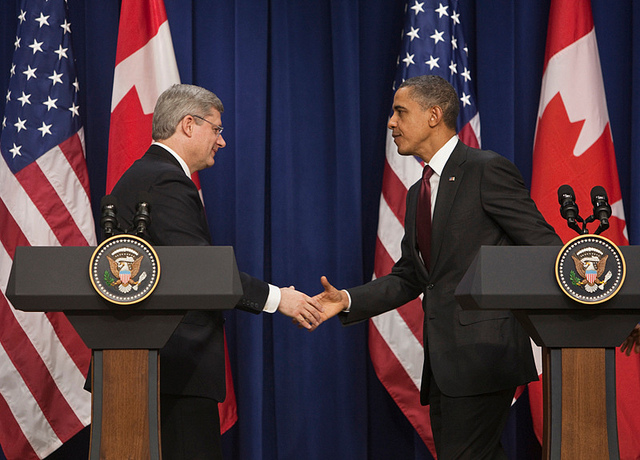Unlike Australia, Canada did not send troops to fight alongside U.S. forces in two major military and political failures: Vietnam (1965-73), and the second invasion of Iraq (2002-2011).
Former Australian Prime Minister Malcolm Fraser thinks Canada was wise to stay out of the U.S. military adventures, though after nearly 12 years in Afghanistan, he notes Canada, like Australia, is part of a “failure in waiting.”
Long considered as pro-American, as well as conservative in his views, Fraser now thinks Australians should be wary of supporting the latest major American foreign policy initiative, “the pivot” towards China.
Malcolm Fraser gives Canada more credit for independence than its foreign policy action warrants. Canada joined the 1993 U.S.-led invasion of Iraq, and promoted it as a UN-endorsed action.
Canada fell in line with the American declaration of war on terrorism after September 11, 2001. The planned acquisition of F-35 first strike aircraft by the Conservatives cannot be explained by external threats to Canadian territory, but does fit with a supporting role in U.S. military operations.
Successive Canadian governments have willingly aligned Canada to U.S. international economic policy. Since the early 1980s, Canada has been an active supporter of the U.S. agenda in the great economic war, designed to free large corporations (mainly U.S. owned) from legislative authority, and promote the U.S. economic model to Europe and Japan, and now China.
Canada is an active promoter of the American practice of signing bilateral investment accords with other nations, with 24 pacts now in force, 12 awaiting ratification, and 13 being negotiated.
Better understood as protection for absent owners from regulation by democratic or non-democratic governments, these investment deals enshrine private property rights, and put them out of reach of domestic legislators.
The investors’ rights doctrine had pride of place in the Canada-U.S. free trade agreement (FTA), which came into effect Jan. 1, 1989.
Before the FTA, Canada had looked upon itself primarily as a destination for outside investors, given that roughly 50 per cent of the Canadian manufacturing sector was (and is) foreign-owned.
At the UN, and even the OECD, the rich countries club, Canada was ready to join with other nations to establish codes of conduct for multinational (or transnational) corporations. The idea was to protect the small countries from the big country.
In bilateral investment pacts, the practice is that the bigger country exacts what concessions it can from the smaller country.
Pre-FTA, the United States had a history of getting countries to sign foreign ownership agreements before offering trade deals. In the Caribbean basin, for instance, the U.S. was accused of using trade protectionist measures to block successful exporting companies (from countries with new U.S. trade deals), and then using its previously negotiated foreign ownership rights to take over the now depressed exporting company, at a bargain price.
The Canada-U.S. deal did not protect Canada from U.S. trade policy, it applied as before. Under the FTA, Canada agreed to a joint commercial policy with the U.S. which championed a new protectionism through the World Trade Organization. Newly created in 1995, the WTO protected intellectual property rights and rights of establishment, and national treatment in other jurisdictions for giant corporations.
Because its objectives included promoting full employment, the U.S. Congress has refused to adopt the 1948 Havana Charter, signed by 53 governments, which would have created the International Trade Organization. The looser, weaker, GATT (General Agreement on Tariffs and Trade) filled the hole left by the ITO, until it was superseded by the WTO, which incorporated its main provisions.
The 1944 Bretton Woods conference rejected the U.K. Keynes plan, which provided for settlement of trade deficits through an international currency union. The U.S. option prevailed: foreign exchange trading. U.S. banks made markets in national currencies (traded against the U.S. dollar), and collected fees on every transaction. The IMF charter identified the U.S. dollar as the key currency.
Whether it be politics (UN), money (IMF), trade (WTO), agriculture (FAO), postal service (UPU), or any other subject, working with all other nations through multilateral organizations was for many years official Canadian policy. Canada agreed to surrender sovereignty to near universal membership bodies founded on international law in order to advance and protect its objectives more completely and efficiently than it could acting alone.
In trade for example, under the GATT rules, a concession made by one country was available to all countries. So when the U.S. made a concession to Europe, Canada benefited. In bilateral talks with the U.S. or Europe, each concession gained requires that Canada give up something in return.
The advantage to the multilateral route is obvious, unless the idea from the start is to give up government sovereignty to one other nation, or, as with the Canada-EU deal, to one group of nations.
Instead of weakening and distorting the multilateral trading system through bilateralism and adherence to the U.S. agenda aimed at protecting corporate rights through the WTO, Canada should be working with other countries to build a trade and investment regime that works for small, weaker nations, and restrains the worst instincts of corporate America.
Duncan Cameron is the president of rabble.ca and writes a weekly column on politics and current affairs.
Photo: photoswebpm/flickr



